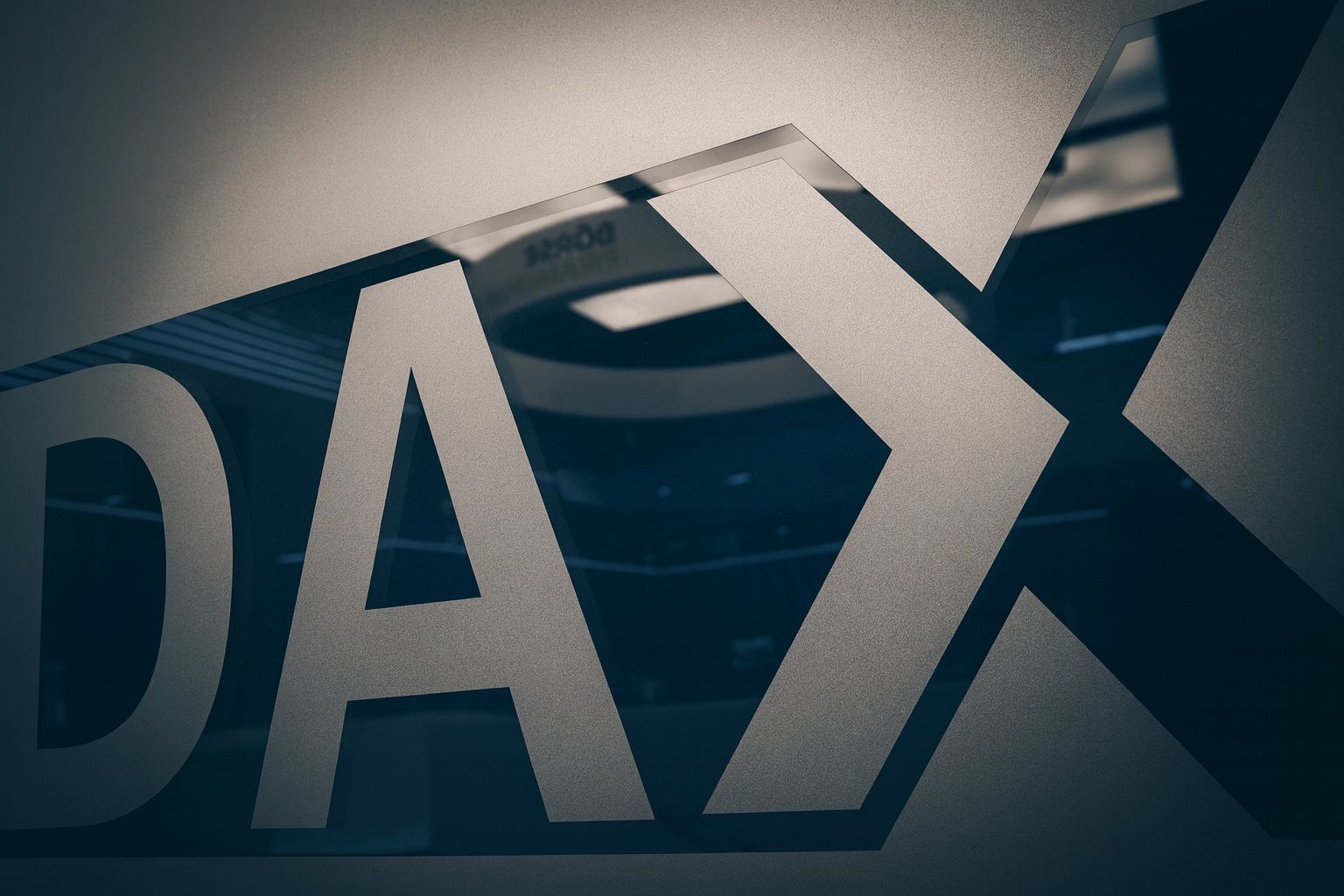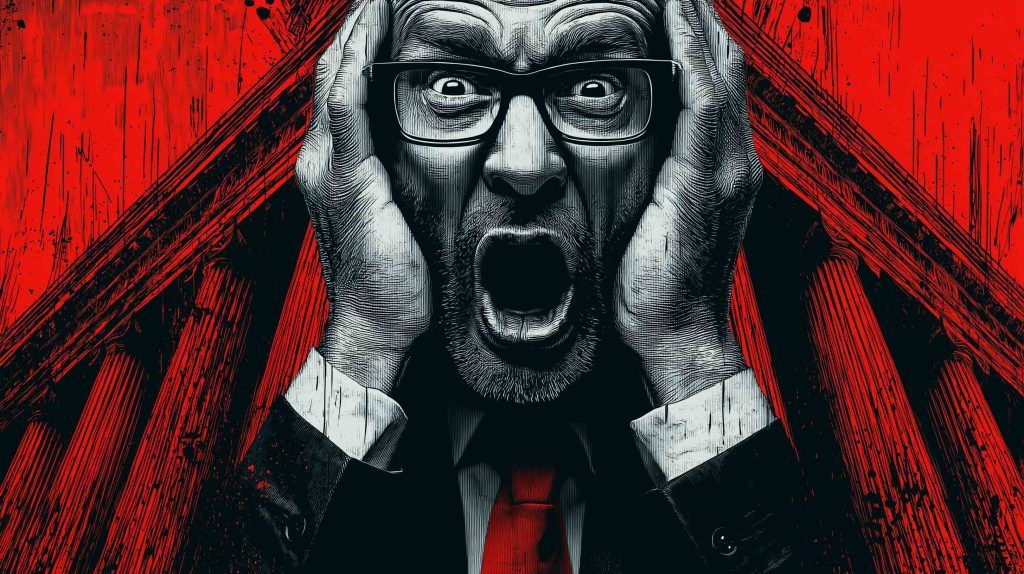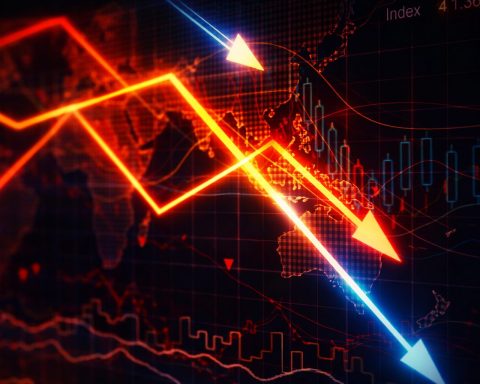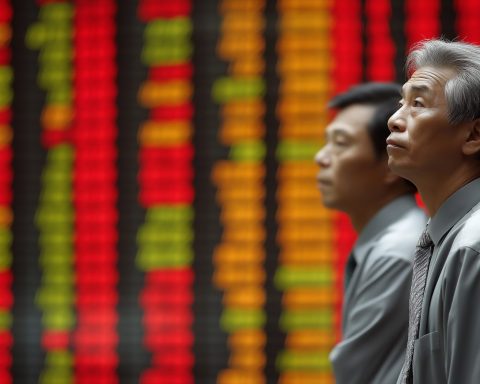- U.S. bank shocks ignite panic: Two U.S. regional lenders – Zions Bancorp and Western Alliance – stunned investors with surprise bad loan losses and fraud allegations, sparking fears of a new banking crisis [1]. Zions disclosed a $50 million loan loss tied to alleged fraud (sending its stock plunging ~13% on Oct. 16) while Western Alliance fell ~11% after suing over a similar “bad” loan [2].
- $100 B wiped out in a day: The revelations erased over $100 billion in U.S. bank stock value as investors rushed to “sell first and ask questions later.” The KBW Regional Banking Index sank ~5–6%, dragging major indexes down – the S&P 500 slid nearly 1% and the Dow Jones lost almost 400 points on Thursday [3]. Even banks with no direct links got slammed (Jefferies Financial tumbled ~10% on contagion fears) [4].
- DAX plunges under 24,000: Germany’s DAX index slumped about 2% on Friday, breaching the 24,000 mark for the first time in weeks [5]. Bank stocks led losses – Deutsche Bank slid around 6% [6] – as Europe’s Stoxx 600 bank index dropped ~3%. Other European markets fell in tandem (London’s FTSE 100 –1.5%, France’s CAC 40 –1.5%) [7] amid spreading credit jitters.
- Rush to safe havens:Gold prices shot to a record high above $4,378/oz – up ~8% this week, the biggest weekly jump since 2008 [8] – as nervous investors sought safety. Bond yields plunged to multi-year lows (U.S. 10-year under 4%, 2-year ~3.38%) as markets fully priced in Federal Reserve rate cuts [9]. In contrast, oil prices fell to five-month lows near $60 on hopes a possible Trump-Putin peace summit could ease geopolitical risks [10].
- Cautious outlook, but no crisis – yet: Analysts are drawing parallels to 2023’s banking turmoil (Silicon Valley Bank, etc.) and warn that recent “one-off” credit flare-ups could foreshadow a broader pullback. Some strategists see the potential for another 5–10% market correction as these scares play out [11]. However, many experts (and bank executives) insist the troubles are isolated – “the bull market remains intact,” one noted, believing the economic expansion and stock rally “may bend but not break” if deeper cracks don’t emerge [12].
U.S. Bank Fraud Shocks Ignite Global Selloff
Investors worldwide were rattled after back-to-back fraud scandals at two U.S. regional banks triggered a crisis of confidence in credit markets. On October 16, Utah-based Zions Bancorporation revealed a sudden $50 million loss on two commercial loans tied to alleged borrower fraud – an “ostensibly isolated” hit that nevertheless sent its shares plunging 12–13%, the worst one-day drop in six months [13] [14]. Phoenix-based Western Alliance Bancorp – a peer that lent to related borrowers – fell about 10–11% in sympathy after disclosing its own fraud lawsuit filed in August [15]. “The fact another respected regional bank was even tangentially caught up in a fraud scenario shook confidence,” observed one market analysis, as seeing two banks caught off-guard in the same week put investors on edge [16].
What might normally be dismissed as isolated incidents quickly snowballed into a broader selloff. “When you see one cockroach, there are probably more,” JPMorgan CEO Jamie Dimon warned this week, cautioning that initial trouble can signal deeper issues ahead [17]. Indeed, traders reacted with a “sell first, ask questions later” mentality [18]. “Where there is smoke, there is often fire,” added IG Markets analyst Tony Sycamore, noting that while 2023’s bank failures were stemmed by quick fixes, those measures may have left “a tinderbox for another banking flare-up” in 2025 [19]. Memories of the Silicon Valley Bank (SVB) collapse in March 2023 – which unleashed a global banking scare – loomed large. “Investors will have memories of how problems in regional banks in 2023 sparked a sharp decline in global bank stock prices,” said Vasu Menon of OCBC Bank [20]. In this case, the disclosures from Zions and Western Alliance – relatively small banks (each under $10 billion market cap) – “drew inevitable comparisons to the regional bank stress” of 2023, noted Deutsche Bank strategist Jim Reid, raising broader questions about credit quality after a lengthy period of high rates and a boom in private credit* [21].
U.S. bank stocks plunged: The KBW Regional Banking Index sank ~5.8% on Oct. 16 [22], and 74 U.S. bank stocks shed over $100 billion in combined market value in one day [23]. Even big institutions weren’t spared: Jefferies Financial – which had exposure to a recent auto-loan bankruptcy – tumbled ~9–10% as “what’s next?” contagion fears spread [24]. Major U.S. indexes recoiled: the S&P 500 fell nearly 1%, while the Dow Jones Industrial Average abruptly reversed a 300+ point morning rally to close almost 400 points down by Thursday’s close [25]. “What we see in the banks selling off overnight in the U.S., Asia wakes up to it, Europe wakes up to it, and so it spreads,” observed James Rossiter, head of global macro strategy at TD Securities [26].
DAX Sinks Below 24,000 as Europe Feels the Jitters
By Friday Oct. 17, the market tremors reached Europe, hitting bank stocks and broader indices across the continent. Germany’s blue-chip DAX index nosedived at the opening bell – falling hundreds of points and breaking below the 24,000 level for the first time in weeks [27] [28]. By midday the DAX was down about 2% around 23,780, marking its steepest drop in over a month [29]. “The weak credit condition of American regional banks is jolting investors out of their AI- and rate-driven euphoria,” commented Jochen Stanzl, chief market analyst at CMC Markets, noting that the news rekindled “bad memories” of the spring 2023 bank collapses [30]. Traders in Frankfurt “followed the pessimism of U.S. investors” from the night before, as “the problems of two U.S. regional banks completely flipped sentiment,” said Thomas Altmann of QC Partners [31] [32]. Fears of a “womöglich nächsten Bankenkrise” (“possible next banking crisis”) took hold [33].
Bank stocks led the decline: Shares of Germany’s largest lenders were hammered – Deutsche Bank dropped roughly 6% and Commerzbank about 3–4% [34]. The pan-European Stoxx 600 Banks index slid ~2.7% [35], with UK’s Barclays down ~6% and France’s Societe Generale down 4–5% [36]. “Investors are nervous, with valuations across equity markets already high,” noted one strategist, pointing out that European bank stocks had surged ~40% year-to-date before this pullback [37].
It wasn’t all gloom in Frankfurt, however. A few corporate bright spots tempered the decline. Auto parts and tire maker Continental AG saw its stock jump +8% – an outlier winner – after reporting much stronger-than-expected quarterly earnings, especially on operating margin [38]. “The company wildly beat market expectations for Q3,” traders noted, triggering a short-covering bounce even amid the market selloff. Volkswagen also ticked up ~1%, and Porsche AG rose +1.2%, after news that VW’s CEO Oliver Blume will step down from his dual role as Porsche chief to refocus on the parent company – a move JPMorgan analysts called a “positive step” toward renewed growth at Porsche [39]. Those gains, however, were overwhelmed by losses in financial and defense stocks. Defense contractors like Rheinmetall and Hensoldt – high-flyers this year – sank 5–7% on profit-taking amid signs geopolitics may be shifting [40]. Reports that President Donald Trump (fresh off brokering a Middle East ceasefire) plans to meet Russia’s Vladimir Putin to discuss ending the Ukraine war caused investors to brace for potential cuts in defense spending [41].
By the close, the DAX had pared some losses but remained firmly in the red. The index finished around 23,745, down slightly from the prior day (after clawing back intra-day lows) [42]. Analysts characterized it as a sharp but not yet catastrophic correction. “The development is sobering, but from a chart-technical perspective nothing dramatic has happened,” said Robomarkets analyst Martin Utschneider, maintaining an optimistic medium-term view [43]. It’s worth noting the DAX had been on an AI-fueled tear earlier in October – even hitting a record high of 24,771 just over a week ago [44] – before trade war worries and now bank fears cut that rally short. Despite this week’s stumble, the index is still up roughly ~19.5% for 2025 so far [45], leaving some cushion for wary investors.
Safe Havens Surge as Gold Hits Record High, Oil Retreats
With equities wobbling, money quickly flowed into traditional safe havens. Chief among them, gold prices have skyrocketed over the past week. On Friday, gold hit an all-time high of around $4,378 per ounce, capping a ~8.5% weekly gain – its largest since the 2008 financial crisis [46]. The yellow metal has now notched record highs for six sessions in a row, noted N-TV, as anxious investors seek shelter from the brewing credit storm [47]. “The newly flared worries about U.S. regional banks give traders yet another reason to buy gold,” explained Tim Waterer, chief analyst at KCM, who added that $4,500 could be the next target sooner than expected if turmoil persists [48]. Gold’s steep rise underscores a broader “risk-off” rotation across markets. “Jittery investors [are] turning to safe haven assets,” wrote The Guardian, as the bank scare provided “a further reason to seek refuge.” [49] [50]
Global bond markets also flashed warning signals. U.S. Treasury yields plunged to multi-year lows amid a dash for high-quality bonds and speculation the Federal Reserve will intervene. The benchmark 10-year Treasury yield sank below 4.0% – the lowest level this year – while the 2-year yield tumbled to ~3.38%, a low not seen in three years [51]. Traders are now fully pricing in a Fed rate cut as early as October, according to Reuters data [52], expecting policymakers might ease monetary conditions if credit stress threatens the economy. In Europe, German Bund yields likewise fell, and the Swiss franc – another safe haven – appreciated notably [53]. Meanwhile the VIX volatility index, Wall Street’s “fear gauge,” spiked roughly 20% to its highest since May, reflecting the sudden surge in risk aversion [54].
In contrast, oil prices have been sinking. Brent crude fell to about $60–61 per barrel, the cheapest in over five months [55] [56]. Weighing on oil was a mix of factors: fears that a banking slowdown could crimp energy demand, and geopolitical news suggesting some conflicts may ease. In a surprising development, U.S. President Trump and Russia’s Putin agreed to meet – reportedly to discuss ending the war in Ukraine – following a newly brokered ceasefire in the Middle East [57] [58]. The mere possibility of de-escalation among major powers has pressured oil, outweighing concerns from the ongoing Israel-Gaza conflict or OPEC cuts. “Oil is getting even cheaper,” N-TV noted at midday, as Brent and WTI each slid about 1.2% on Friday [59]. Energy markets appear to be betting on a cooler geopolitical climate and perhaps slower growth, at least for now.
Outlook: ‘One-Off’ Blunders or The Tip of an Iceberg?
The big question for investors is whether these bank credit scares are isolated events or early warnings of deeper trouble ahead. Thus far, many banking executives and regulators are insisting the system is sound. Zions’ management was quick to call its $50 million fraud loss “an isolated case,” even hiring outside investigators to ensure no other hidden issues lurk [60]. Western Alliance’s CEO similarly emphasized that their problem loan was identified and secured, and noted that overall “criticized” (at-risk) assets had actually declined in recent months [61]. Big U.S. banks also don’t appear overly alarmed – the top five Wall Street banks collectively set aside the smallest loan-loss reserves in two years last quarter, signaling they “aren’t bracing for a credit apocalypse,” as one analysis pointed out [62] [63]. In fact, despite the turmoil, analyst sentiment on regional banks remains cautiously optimistic: Western Alliance stock is still rated a “Strong Buy” by a majority of analysts with a target price about 30% above current levels, and Zions is viewed as fairly valued (“Hold”) with significant upside if fears subside [64] [65].
That said, nerves are still raw. Financial experts note that a string of recent corporate defaults – from subprime auto lender Tricolor (which filed bankruptcy amid fraud allegations) to auto-parts maker First Brands (which collapsed owing $10 billion) – has shaken confidence in credit quality [66]. “It shows you can’t take credit quality for granted, and poor credit at one bank can drag down the group fast,” warns Stephen Biggar, an analyst at Argus Research [67]. Francesco Pesole, strategist at ING, agrees that so far “the risks appear more isolated this time, but they could feed into a narrative that the U.S. business environment and credit quality are in a poorer state than data suggests.” [68] In other words, investors are questioning whether these loan fraud surprises are mere one-offs – or “the first cockroach scurrying out of the pantry,” as one market observer vividly put it [69].
Market strategists are split on what comes next. Some predict more volatility ahead: “Sentiment remains skittish,” one strategist told TS², suggesting investors might demand a larger risk premium until bank earnings reassure them [70]. A few warn of another 5–10% pullback in equities as the market digests these credit scares and any other skeletons that emerge [71]. Concerns about a broader credit crunch – if regional banks tighten lending – and the impact of still-high interest rates are adding to caution. As Neil Wilson of Markets.com put it, “Add in worries over trade wars and the ever-growing AI bubble risk, and you get a pretty nasty little cocktail of excuses to go risk-off.” [72]
Others remain upbeat, viewing this episode as a healthy reality check. “Unlike in 2023, the risks appear more contained, not systemic,” noted one investment bank, arguing that well-capitalized institutions and vigilant regulators make a full-blown crisis unlikely [73] [74]. Pullbacks could even present buying opportunities. “The bull market remains intact,” insist optimists, who believe the 2025 economic expansion – and stock rally – “may bend but not break” despite these jitters [75]. As long as corporate earnings stay solid and any bank losses are manageable, they expect the market’s uptrend will resume once the fear subsides. Indeed, by late Friday some stability was returning: U.S. regional bank stocks were off their lows, and the DAX itself steadied after its initial plunge [76].
For now, all eyes are on upcoming bank earnings and credit updates. Zions and Western Alliance will report results on Oct. 20–21, where executives will be pressed to prove these losses truly were one-offs [77]. Any additional surprises could reignite panic, but reassuring guidance may help put a floor under the sector. As JPMorgan analysts observed, the market tends to “sell first and ask questions later” when shocked [78] – so restoring confidence will be key. In the meantime, the events of this week serve as a stark reminder that after a long period of easy money and rapid loan growth, hidden risks can still lurk in the financial system. As JPMorgan’s Dimon implied with his cockroach analogy, one nasty discovery often means more are hiding – a notion keeping investors on edge. “The fear of a new crisis is back,” summed up QC Partners’ Altmann [79]. Whether that fear fades or snowballs may determine if this October market stumble is just a blip – or the start of something more.
Sources: Market analysis and expert quotes from TS² TechStock [80] [81] [82], Reuters [83] [84], The Guardian [85] [86], dpa-AFX/Ariva [87] [88], and N-TV [89] [90].
References
1. www.theguardian.com, 2. ts2.tech, 3. ts2.tech, 4. ts2.tech, 5. www.theguardian.com, 6. www.reuters.com, 7. www.theguardian.com, 8. www.theguardian.com, 9. ts2.tech, 10. www.n-tv.de, 11. ts2.tech, 12. ts2.tech, 13. ts2.tech, 14. ts2.tech, 15. ts2.tech, 16. ts2.tech, 17. ts2.tech, 18. ts2.tech, 19. ts2.tech, 20. www.reuters.com, 21. www.theguardian.com, 22. ts2.tech, 23. ts2.tech, 24. ts2.tech, 25. ts2.tech, 26. www.reuters.com, 27. www.ariva.de, 28. www.n-tv.de, 29. www.n-tv.de, 30. www.ariva.de, 31. www.n-tv.de, 32. www.n-tv.de, 33. www.ariva.de, 34. www.ariva.de, 35. ts2.tech, 36. www.reuters.com, 37. www.reuters.com, 38. www.ariva.de, 39. www.ariva.de, 40. www.ariva.de, 41. www.ariva.de, 42. fundscene.com, 43. www.ariva.de, 44. www.ariva.de, 45. www.ariva.de, 46. www.theguardian.com, 47. www.n-tv.de, 48. www.n-tv.de, 49. www.theguardian.com, 50. www.theguardian.com, 51. ts2.tech, 52. www.reuters.com, 53. www.reuters.com, 54. ts2.tech, 55. www.finanzen.net, 56. www.n-tv.de, 57. www.ariva.de, 58. www.n-tv.de, 59. www.n-tv.de, 60. ts2.tech, 61. ts2.tech, 62. ts2.tech, 63. ts2.tech, 64. ts2.tech, 65. ts2.tech, 66. ts2.tech, 67. ts2.tech, 68. www.reuters.com, 69. ts2.tech, 70. ts2.tech, 71. ts2.tech, 72. www.n-tv.de, 73. ts2.tech, 74. ts2.tech, 75. ts2.tech, 76. www.n-tv.de, 77. ts2.tech, 78. ts2.tech, 79. www.n-tv.de, 80. ts2.tech, 81. ts2.tech, 82. ts2.tech, 83. www.reuters.com, 84. www.reuters.com, 85. www.theguardian.com, 86. www.theguardian.com, 87. www.ariva.de, 88. www.ariva.de, 89. www.n-tv.de, 90. www.n-tv.de










